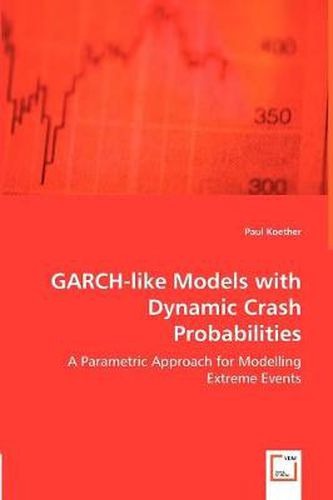Readings Newsletter
Become a Readings Member to make your shopping experience even easier.
Sign in or sign up for free!
You’re not far away from qualifying for FREE standard shipping within Australia
You’ve qualified for FREE standard shipping within Australia
The cart is loading…






This title is printed to order. This book may have been self-published. If so, we cannot guarantee the quality of the content. In the main most books will have gone through the editing process however some may not. We therefore suggest that you be aware of this before ordering this book. If in doubt check either the author or publisher’s details as we are unable to accept any returns unless they are faulty. Please contact us if you have any questions.
We work in the setting of time series of financial returns. Our starting point are the GARCH models, which are very common in practice. We introduce the possibility of having crashes in such GARCH models. A crash will be modeled by drawing innovations from a distribution with much mass on extremely negative events, while in normal times the innovations will be drawn from a normal distribution. The probability of a crash is modeled to be time dependent, depending on the past of the observed time series and/or exogenous variables. The aim is a splitting of risk into normal risk coming mainly from the GARCH dynamic and extreme event risk coming from the modeled crashes. For the ARCH case we formulate (quasi) maximum likelihood estimators and can derive conditions for consistency and asymptotic normality of the parameter estimates. On the practical side we look for the outcome of estimating models with genuine GARCH dynamic and compare the result to classical GARCH models. We apply the models to Value at Risk estimation and see that in comparison to the classical models many of ours seem to work better although we chose the crash distributions quite heuristically.
$9.00 standard shipping within Australia
FREE standard shipping within Australia for orders over $100.00
Express & International shipping calculated at checkout
This title is printed to order. This book may have been self-published. If so, we cannot guarantee the quality of the content. In the main most books will have gone through the editing process however some may not. We therefore suggest that you be aware of this before ordering this book. If in doubt check either the author or publisher’s details as we are unable to accept any returns unless they are faulty. Please contact us if you have any questions.
We work in the setting of time series of financial returns. Our starting point are the GARCH models, which are very common in practice. We introduce the possibility of having crashes in such GARCH models. A crash will be modeled by drawing innovations from a distribution with much mass on extremely negative events, while in normal times the innovations will be drawn from a normal distribution. The probability of a crash is modeled to be time dependent, depending on the past of the observed time series and/or exogenous variables. The aim is a splitting of risk into normal risk coming mainly from the GARCH dynamic and extreme event risk coming from the modeled crashes. For the ARCH case we formulate (quasi) maximum likelihood estimators and can derive conditions for consistency and asymptotic normality of the parameter estimates. On the practical side we look for the outcome of estimating models with genuine GARCH dynamic and compare the result to classical GARCH models. We apply the models to Value at Risk estimation and see that in comparison to the classical models many of ours seem to work better although we chose the crash distributions quite heuristically.